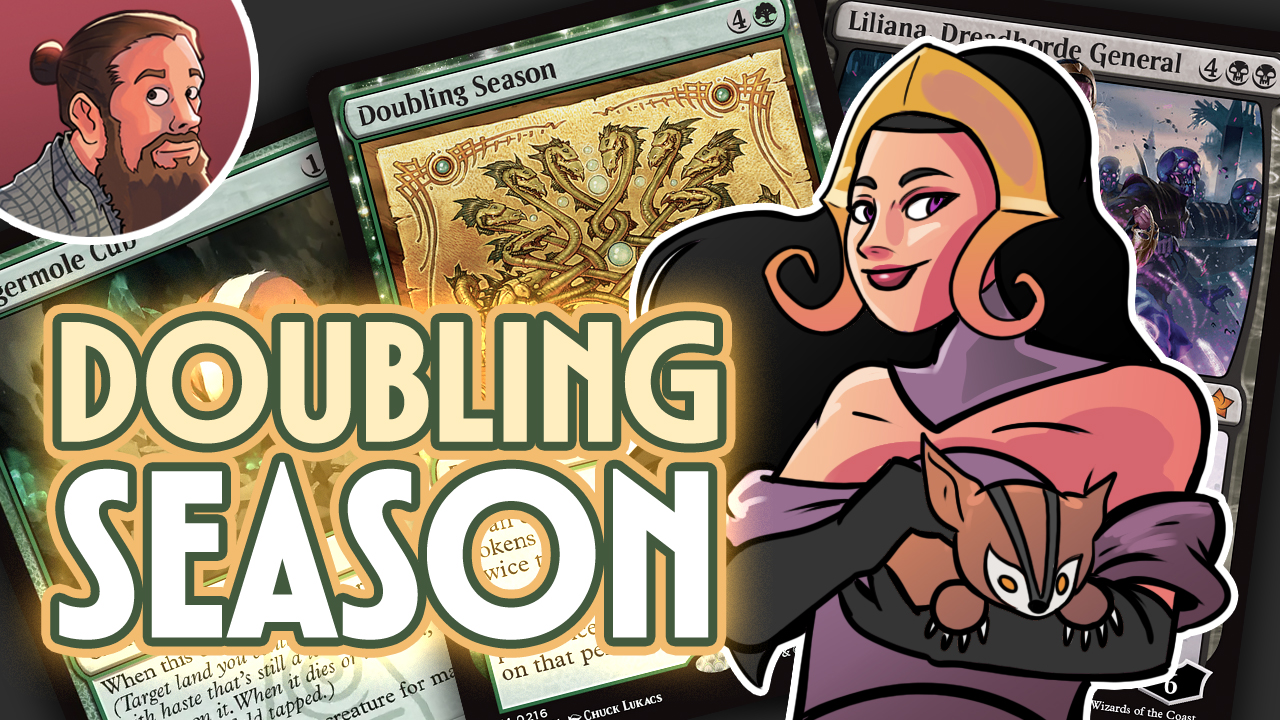The Lands of Oath of the Gatewatch
If there is one thing that says "Zendikar" above all else, it is the lands — the interesting, powerful, and unique lands. Thankfully Oath of the Gatewatch, the newest set featuring the plane, is no different. According to the name and number crunch posted on MTGSalvation, we already know all of the lands that will be printed in the set. And even though we have another week of spoilers to go, we have a window where we can talk about the lands from the set with some sense of completion.
Generally, lands are among the most constructed playable cards in a Magic set, simply because the opportunity cost of including lands in a deck is so low. No matter what Standard deck you choose, you are going to be devoting somewhere between one third and one half of your deck to lands. When a new land sees print, it is fighting a comparatively small pool of cards for a relatively large number of guaranteed slots in a deck. As such, it doesn't take all that much for a land to be constructed playable.
So today we are going to take a few minutes to talk about all of the new lands from Battle for Zendikar, focusing on their potential playability in Standard and Modern, and what decks they might fit in. One of the unique things about several of the Oath of the Gatewatch lands is that you need access to colorless mana to activate their ability. Before breaking down the lands, we need to discuss the ways to generate colorless mana in the Standard. If adding colorless mana is a major cost or deck building restriction, some seemingly powerful lands (and other Oath cards for that matter) may be left on the sidelines of the format. Easy access to colorless mana, instead, would be a vote of confidence for the playability of many of these cards.
How to Add Colorless Mana in Standard
In Oath of the Gatewatch we are getting some very powerful colorless cards. However, unlike old generic cards, being colorless is a very real cost. If Mirrorpool could be activated for one-mana of any color, it would likely be one of the best lands printed in years. But just how much of a drawback is the requirement that the activation cost be paid with colorless mana? Let's look at the most common ways to make colorless mana in our current Standard format.



Clearly the easiest and best way to access colorless mana in Standard is the painland cycle, most recently seen in Magic Origins. In a world that values colorless mana almost as much as a colored mana, each land in this cycle suddenly becomes the equivalent of a tri-land that enters the battlefield untapped. You can use Shivan Reef to cast all your Blue spells, cast all your Red spells, and activate a Mirrorpool or cast a Kozilek, the Great Distortion. If colorless cards are good enough, it might be a reason for the painlands to overtake the Battle for Zendikar duals as the most played lands in Standard once fetch lands rotate in April. It's probably not a bad idea to pick up your playset now since they are incredibly cheap at around $1 per copy.
Other Colorless Lands


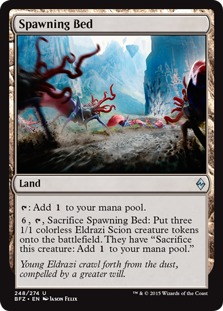

The rest of these cards are the reason I hate Wastes for constructed. Yes, an ultra-common colorless land is probably necessary for limited, but when it comes to playing tournament Magic, why wouldn't you play a colorless land with upside over Wastes? Of course there are exceptions. If your plan is to Explosive Vegetation or Nissa's Renewal into colorless lands for Kozilek, the Great Distortion, the fact that you can search out Wastes is a pretty big deal. But unless you are playing cards that say "search your library for a basic land," play Tomb of the Spirit Dragon, Foundry of the Consuls, Spawning Bed, or any of the colorless lands from Oath of the Gatewatch.
Regardless, truly colorless lands are one of the better ways of activating a Mirrorpool or casting Kozilek, the Great Distortion. In most decks they will be better (i.e. the opportunity costs are lower) than the other fringe ways of making colorless mana in Standard.
Eldrazi Scions

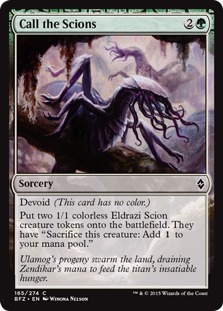
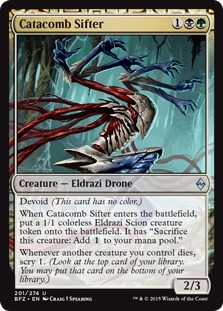
I'm not sure that Eldrazi Scion producers are the type of cards you can play in a deck just because you need colorless mana. If your deck doesn't really want Eldrazi Skyspawner, it probably isn't worth playing it just to get the 1/1 Scion token. On the other hand, if you are playing a deck that naturally plays a bunch of Scion producers (e.g. a deck with Catacomb Sifter), you might be able to squeeze in a couple of colorless spells or lands with colorless activation costs because you'll naturally have access to colorless mana.
The Lands of Battle for Zendikar
Mirrorpool
Mirrorpool is clearly an extremely powerful Magic card. It only takes up a land slot, taps to add mana, and has two powerful abilities. While it probably isn't something every deck will want, assuming you are playing enough colorless mana to activate it consistently, I would imagine that a lot of decks will want it. I mean, it's a land that can double-up on Dig Through Time for only four-mana, and copy a Siege Rhino for six-mana. It can do either of these things at instant speed. At first glance this card seems incredibly busted. The only question is, how much does playing enough colorless mana to activate Mirrorpool warp your deck building process?
Let's assume you start with four copies of Mirrorpool, which amounts to four colorless sources in and of itself. Obviously, this isn't enough to consistently have two colorless sources on the battlefield to activate Mirrorpool. Now, let's say you are a wedge deck like Jeskai or Mardu. Now you have access to eight painlands which you can jam into your deck, upping your number of colorless producing lands to 12. Half of your lands will be able to produce colorless mana, while 83% percent of your lands will still be able to produce colored mana. This number should be more than enough colorless sources to activate Mirrorpool.
The bigger issue is how many percentage points you give up by playing so many painlands. I've used painlands in a lot of budget decks, and I can tell you that with eight painlands, you sometimes lose games because you pay half of your life total to play your spells on time. This tax is especially true when you are trying to cast things like Mantis Rider or Savage Knuckleblade.
These clan affiliated cards highlight another problem with colorless lands. At least until rotation, many of the most powerful spells in Standard are wedge-colored. Playing a single Mirrorpool in the early game means you aren't able to cast Mantis Rider or Abzan Charm until turn four at the earliest. As such, wedge decks aren't going to be interested in many (or possibly any) colorless lands.
This belies the hidden opportunity cost of Mirrorpool. While it is only taking up a land slot in your deck, it is costing you the opportunity to take advantage of the incredible mana in Standard brought to you by fetch lands and Battle for Zendikar duals. In essence, you are giving up the opportunity to cast Abzan Charm on time for the chance to copy an Abzan Charm.
As such it seems unlikely Mirrorpool will be that amazing in Standard, at least until rotation, when the equation changes significantly. As of today, the only tier decks in Standard that can easily jam four colorless lands with colorless activation costs are Atarka Red, which could use Mirrorpool as a hedge against flooding out, and Eldrazi Ramp, which already plays eight colorless lands.
I think Mirrorpool will be very good eventually, but I don't think it is good enough to convince players to give up their Mantis Riders and Abzan Charms, or give up fetching duals. After the April rotation all bets are off.
Sea Gate Wreckage
Any land with the text "draw a card" is worth taking a look at, simply because we have undeniable proof that drawing cards with a land can be incredibly broken (e.g. Library of Alexandria). Paying three-mana isn't a deal breaker. Desolate Lighthouse has become a Modern staple and it costs three to activate and it doesn't generate card advantage. On the other hand, Grim Backwoods draws a card, but requires four-mana and sacrificing a creature, and is unplayable. If the drawback is too high, even a land that draws a card isn't good enough. Is Sea Gate Wreckage closer to Desolate Lighthouse or Grim Backwoods?
My guess is that it falls somewhere in the middle, but closer to Grim Backwoods than Desolate Lighthouse. Control decks are unlikely to want it because they don't like playing empty handed. With so many good colorless options available in our current Standard, it seems likely control will use those slots for Mage-Ring Network or Foundry of the Consuls. On the other hand, if there is an aggro deck that doesn't mind colorless mana, Sea Gate Wreckage could be very good. Remember, the combo of Become Immense and Temur Battle Rage is rotating in April. Red aggro will have to be more concerned with playing a real game of Magic. Being able to spew your hand and then draw an extra card every turn seems like a good way to grind out the fair game. Plus with Become Immense and fetchlands gone, there will be less of a reason to splash green. In a mono-colored deck, using four slots on a colorless land (and maybe some Red painlands) is probably fine.
Sea Gate Wreckage is only for dedicated aggro decks, and like Mirrorpool, is unlikely to be good enough before rotation. I could imagine it being a four-of in an aggro deck at some point in its Standard life.
Ruins of Oran-Rief
Ruins of Oran-Rief is an odd card. According to every Affinity player I've talked too, it is simply too slow and weak to see play in Modern. If it has a home it will likely be Standard. The problem is, what deck is going to have enough colorless creatures to make this playable, and also want to put counters on their creatures? Obviously this isn't for a big Eldrazi deck. Making Ulamog, the Ceaseless Hunger an 11/11 instead of a 10/10 is utterly irrelevant. Instead, we are looking for a deck that is playing a lot of small, colorless creatures.
Let's assume we are playing some sort of Eldrazi Aggro deck. Is it really worth paying an extra mana (or playing off-curve) to make a 2/2 into a 3/3, while also having to play colorless lands? I'm leaning towards no. The other problem is that, in an aggro deck, it is competing with Sea Gate Wreckage for the colorless land slot. Most of the time I would rather be drawing an extra card than putting a single +1/+1 counter on a creature that entered the battlefield this turn.
While I'm sure Ruins of Oran-Rief is not good enough for tournament tables, I did want to mention Eldrazi Scions. In theory, you can play something like From Beyond to get a free colorless creature every turn and then tap your Ruins of Oran-Rief to make it bigger. Like I said, it doesn't sound competitive, but at least it's fun on kitchen tables.
Ruins of Oran-Rief ranks near the bottom of the Rare lands from Battle for Zendikar. It seems unlikely to find a home in Standard, either now or after rotation.
Corrupted Crossroads
Corrupted Crossroads is emblematic of everything I dislike about the mechanics of Battle for Zendikar block. If you think about it, what the card actually says is "Pay 1 life: Add one mana of any color to your mana pool. Use this mana only to cast colorless spells," which is oxymoronic on its face.
That said, one of my pet archetypes is Eldrazi Aggro, which is basically all devoid creatures. Having access to Corrupted Crossroads will be great for the deck. My version of the deck was straight Black-Red, but there are some powerful Green devoid cards like Catacomb Sifter and even some Blue devoid cards like Eldrazi Skyspawner. While non-budget decks can play these cards anyway with the help of fetch lands and Battle for Zendikar duals, Corrupted Crossroads will provide a strong budget option for a three- or four-color Eldrazi Aggro deck. While I find it awkward that a card with this wording exists (it feels like a sorcery speed counterspell to me) and I don't expect it to make waves in tournaments, I'm also happy to have access to it because it improves Eldrazi Aggro.
Hissing Quagmire
While having deathtouch isn't a surprise, I'm pretty happy with how Hissing Quagmire turned out. It's one of the best (if not the best) defensive creaturelands ever printed. Obviously, if you are looking to beat down, Treetop Village, Mutavault, and Raging Ravine are better. When you are looking to block and trade with an opposing Tarmogoyf, nothing gets the job done like Hissing Quagmire.
My main focus here is Modern, simply because on-color creaturelands are always good enough for Standard. It doesn't really matter what their abilities may be. If you are playing Abzan in Standard, you'll be running some number of Hissing Quagmires, no questions asked. Whether or not Hissing Quagmire will be a Modern staple is a more interesting question. BGx is one of the most popular color combinations in the format, so it has a natural home.
The bad news is that Hissing Quagmire doesn't help cast discard spells like Thoughtseize or Inquisition of Kozilek on turn one. Jund in Modern typically plays 16 turn one untapped Black sources (66%). Is it worth having turn one Thoughtseize less often to have access to another creatureland? I'm not sure. The question is further complicated by the fact that Jund wants to curve out. Discard on turn one, Dark Confidant on turn two, Liliana of the Veil on turn three, which means the first "free" turn to play a tapped land is turn four. Turn four Raging Ravine curves into turn five activate Raging Ravine, which means the deck probably doesn't want to increase the number of tapped lands, at least very much, from the current 16%. It might be able to add one or two additional tap lands, but at that point the deck is getting to the dangerous point of having too many clunky, off-curve draws.

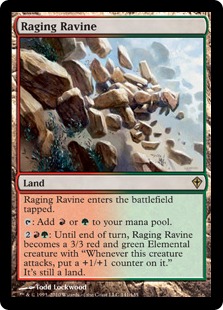
Typically Jund divides up its creatureland slots between Treetop Village and Raging Ravine. The advantage of Treetop Village is that it's inexpensive to activate and can attack through Snapcaster Mage, Dark Confidant, or Thalia, Guardian of Thraben. Raging Ravine is really fast at closing out the game, and once you get in one attack it is out of Lightining Bolt range.
The biggest problem I foresee with Hissing Quagmire is that it dies to a flashed-in Snapcaster Mage, the second most played creature in Modern behind Spellskite. For a GBx deck looking to win the game by grinding out incremental value, attacking with a Hissing Quagmire is a risky proposition. Snapcaster Mage can block Hissing Quagmire and flashback Lightning Bolt to kill a Dark Confidant. Such a loss of value might keep Hissing Quagmire out of the deck altogether.
Finally, the other problem with Hissing Quagmire is that Modern is not a fair format. Sure, having a land that can trade with Tarmogoyf is nice, but there are so many decks that just don't care about a 2/2 with deathtouch (e.g. Tron, Affinity, Burn, Merfolk, Infect, Twin, Amulet Bloom). Being "really good on defense" isn't that much of a benefit in Modern. Regardless of my thoughts, when it comes to BGx decks in Modern, I will defer to the master himself, Hall of Famer Willy Edel. He posted this on Twitter:
"The BG manland looks great for Standard and unimpressive for Modern. That said, it will see Modern play just because it's BG even if it was a 0/2 wall . . . After the unimpressive BG land and a lot of new weapons for Tron decks, I'll be sure R&D really hates me if the UR land is great."
Wandering Fumerole
It's a creatureland, so by default it is playable in Standard. Let's focus on the Modern applications of Wandering Fumarole. First off, UR is a popular color combination in the format. It's possible a few copies of Wandering Fumarole show up in decks like UR Twin simply because the opportunity cost is so low. However, the most exciting aspect of the card is the 0 activation cost for the power / toughness switching ability has the potential to create some new combos.

So here's how the combo works. With Wandering Fumarole on the battlefield, you can activate the 0 ability an infinite number of times giving Ceaseless Searblades infinite power. Then you can kill your opponent in one shot, either by attacking or with the help of Rite of Consumption or Fling. We even have a way to Sneak Attack Ceaseless Searblades into play with Incandescent Soulstoke.

The problem here is two-fold. First, as with all combos in Modern, you have to ask yourself, "Why would I play this over Splinter Twin?" So far I've been unable to come up with a good answer. While the combo may be more resilient than Splinter Twin since you can go off at instant speed in response to a removal spell, it has sorcery speed components. You can't flash in Ceaseless Searblades like you can a Deceiver Exarch. Unless you have a ton of mana (four for Ceaseless Searblades, four to activate Wandering Fumarole, and two for Fling), you have to untap, which can be problematic. On the other hand, if you wait until turn five, you can play Ceaseless Searblades with a handful of Pact of Negations, counter anything that could disrupt your combo, and then kill your opponent with the "you lose the game" trigger on the stack during your upkeep. Second, as I mentioned before, it's just more expensive than the Twin combo. Instead of going three-drop, four-drop, win the game, you are going to need six-mana for the Fling kill.
All in all, I think it's exciting that this combo exists. I can imagine playing it, but I'd be shocked if Ceaseless Searblades and Wandering Fumarole can unseat Deceiver Exarch / Splinter Twin as the best UR combo in Modern.
Needle Spires
Not much to say about Needle Spires. I'm sure it's good enough for Standard, like every other creatureland ever printed, but I'd be shocked to see it break into Modern. If you are going to pay four to activate a creatureland, you want it to be more than a 2/1, even if the 2/1 can attack for four damage on an empty board. I guess there is some extremely slight chance it could show up as a one-of in a Primeval Titan / Kessig Wolf Run deck as a backup win condition, since double strike and trample ends the game fairly quickly, but even in this situation you need access to 16-mana to do 20 damage. The good news is we now have access to the entire cycle of Zendikar / Battle for Zendikar creaturelands, so instead of talking about how much I dislike Needle Spites, here's my Top 10 Rankings.
Top 10 Rankings
- Celestial Colonnade: The most expensive of the cycle, but also the most powerful. Vigilance makes it less expensive than it appears.
- Raging Ravine: Currently the member of the cycle that sees the most play in Modern. It is one of the best offensive creaturelands ever printed, alongside Treetop Village or Inkmoth Nexus (if you take into consideration the entire deck rather than just the card).
- Creeping Tar Pit: This is mostly a shout out to Legacy where Creeping Tar Pit is an assassin for Jace, the Mind Sculptor. If they ever unban Jace in Modern, Creeping Tar Pit would see a jump in play.
- Stirring Wildwood: Currently the second most played of the cycle in Modern, Stirring Wildwood offers a lot of power and toughness compared to its activation cost. Blocking fliers can be relevant.
- Wandering Fumarole: Has a chance to be Modern playable, mostly because Blue-Red is one of the most popular color combinations in the format. As I mentioned earlier, it also has a slight chance of being part of a combo.
- Shambling Vent: Relatively cheap activation cost. Lifelink on a land is better than it seems at first glance.
- Lumbering Falls: Much better than I initially thought for Standard, but probably too expensive and unimpactful to see Modern play.
- Hissing Quagmire: While somewhat disappointing, Willy Edel says he'll likely be playing it at the upcoming Pro Tour Oath of the Gatewatch. Even though it isn't great, it's still technically Modern playable.
- Needle Spires: Blocks Lavaclaw Reaches all day.
- Lavaclaw Reaches: Gets blocked by Needle Spire all day.
Other Lands
I want to mention Crumbling Vestige for two reasons. First, it might be playable in Pauper, although I don't really know enough about the format to say where. Second, and more importantly, with an Amulet of Vigor on the battlefield it is another land that adds two-mana when it enters the battlefield. While this might not matter since we already have the bouncelands, the fact that it can add one-mana of any color could end up being relevant. While the manabase of Bloom Titan decks is one of the more confusing things in Modern, it seems like Crumbling Vestige could have a place as a one-of thanks to its Lotus Petal-like properties.

Holdout Settlement is likely only playable in pauper, but apparently it is really good in the format. In more powerful formats, tapping a creature to produce one-mana of any color just isn't all that appealing. While it looks a lot like Springleaf Drum, the beauty of the drum is that is actually nets you a mana. You can turn an Ornithoper into the mana necessary to cast Signal Pest. Holdout Settlement can already cast Signal Pest, so instead of netting you a mana, all it is doing is fixing your mana at the cost of tapping a creature. Not really that exciting.



Finally, there's also a cycle of enter-the-battlefield-tapped allied-colored dual lands printed at Uncommon. These cards are basically irrelevant for constructed. Currently they are strictly worse than the gainlands from Khans block, and it's not like the gainlands see much tournament play. Being Uncommons, they are not legal in Pauper. The long and short of it is these cards are purely in the set for limited, and at least until the Khans gainlands leave the format, there is absolutely no reason to include these cards in a constructed deck.
TLDR:
- Lands are awesome.
- As long as painlands are in the format, adding colorless mana is relatively easy in Standard, which bodes well for the playability of the Oath of the Gatewatch lands.
- As long as Khans is in the format, the opportunity cost of playing colorless lands is extremely high. Not only are you giving up the best mana Standard has ever seen, but you are also giving up the opportunity to play wedge cards like Abzan Charm and Mantis Rider on time.
- Mirrorpool is extremely powerful and I expect it to see play in Standard eventually, but not until rotation.
- Sea Gate Wreckage might see play in aggro builds that don't mind being hellbent, but its potential is limited since control decks are rarely going to be empty handed.
- Ruins of Oran-Rief seems underpowered and unplayable. Not only does it force an aggro deck to play off-curve, it's worse than Sea Gate Wreckage.
- Corrupted Crossroads could see play in a three- or four-color devoid aggro deck, but I'm not sure this strategy will ever be tier one in Standard.
- All the creature lands are playable in Standard and will be auto-includs in decks of their colors. Wandering Fumarole may see play in Modern and might even be part of a combo with Ceaseless Searblades and Fling. Hissing Quagmire is disappointing, but will likely see Modern play just because of its color. Needle Spires is either the worse, or the second worse creatureland of the entire cycle.
- Crumbling Vestige doesn't seem Standard playable, but it may be good in Pauper, or show up as a one-of in conjunction with Amulet of Vigor in Modern.
- Holdout Settlement is apparently very good in Pauper, but isn't relevant anyplace else.
- The Uncommon ally dual land cycle is for limited only.
A Quick Word of Finance Advice
I wanted to briefly mention two finance topics related to the Oath of the Gatewatch lands. First off, if you don't own a playset of the pain lands from Magic Origins, it probably wouldn't hurt to pick them up now. The supply is massive (they've been reprinted in the last two core sets) so I don't expect a major spike, but the presence of so many "colorless mana matters" cards in Oath of the Gatewatch could bump the painlands past the Battle for Zendikar duals as the most played duals in Standard once fetchlands rotate in the spring. Plus the painlands are dirt cheap. At $1 each they are unlikely to drop any lower. Basically they are a low-risk way to hedge your collection against a price increase this spring based on the potential playability of "colorless mana matters" cards.
For the Oath of the Gatewatch lands themselves, I expect the creaturelands to mimic the Battle of Zendikar versions valuewise. The lower end of the cycle will probably be a couple of dollars, while the most played (especially Wandering Fumarole, since the UR land is almost always the most expensive in the cycle) will likely top out at $5. As for the colorless lands, my plan is to wait a couple months and see how far they fall. Their time to shine will be the April rotation, so wait for the supply to increase and prices to drop, then pick up your copies right when Shadows Over Innistrad spoilers start in March.
Conclusion
That's all for today. What do you think of the lands of Oath of the Gatewatch? What is your ranking of the creatureland cycle? Is there any chance "colorless matters" cards will see play before rotation? How much play will they see after Khans block leaves the format? Leave your thoughts, ideas, opinions, and suggestions in the comments. You can reach me on Twitter (or MTGO) @SaffronOlive.


